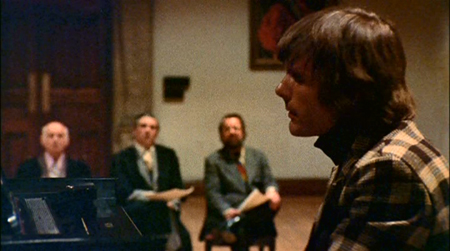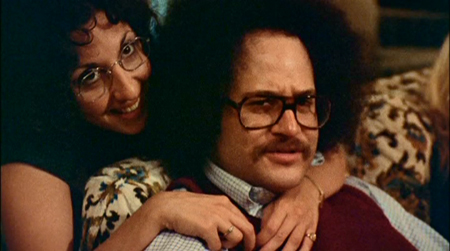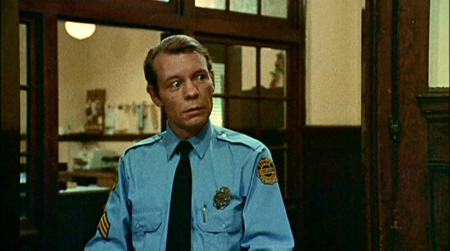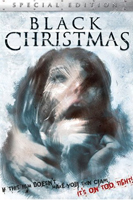BUY IT AT AMAZON: CLICK HERE!
STUDIO: Critical Mass
MSRP: $24.98
RATED: R
RUNNING TIME: 98 Minutes
SPECIAL FEATURES:
• Restored deleted scenes
• "The 12 Days of Black Christmas" featurette
• Interviews w/ Olivia Hussey and Margot Kidder
• Midnight screening Q&A
The Pitch
"It’s
When
a Stranger Calls on holiday!"
The Humans
Olivia
Hussey, Keir Dullea, John Saxon, Margot Kidder.
The Nutshell
It’s a
simple formula: combine a large volume of sorority house with a relatively
small but potent measure of violent freakball. During the Christmas holiday, the
nubile (by 70s standards) young sisters are tormented by obscene phone calls
from their friendly visitor. It starts out as a joke, but as girls begin to
disappear one by one, they begin to learn that the mumbled threats are far from
idle.

"Can we wrap this up? My machete needs cleaning."
The Lowdown
Which
side are you on? Some say John Carpenter invented the slasher subgenre with Halloween.
Others say Bob Clark with Black Christmas. Still others believe
that stringent genre classification leads to misperceptions. Those last are not
fun at parties.
Whatever
the genesis of the type (which is likely less simple than either theory), Black
Christmas does play to many of the modes that slasher movies adopted: first-person
view from the villain, a concern with the loss of sexual innocence, and the
harsh, undeserved punishment of young adults.
Sometimes,
progenitors like this get swept under the rug of history because audiences have
more of an appreciation for the ways these tropes have been evolved than for
their origins. Thanks to a steady competence in employing tension and
ambiguity, Black Christmas is just as watchable today as it was thirty
years ago, and even still has a hint of lemony freshness.

I’m sorry, I couldn’t concentrate on your piano playing because your jacket was too loud.
Its
similarities to modern slashers are intriguing, but it’s the ways in which it’s
different that interest me the most. For example, the descendents of the genre
display promiscuity as an offense punishable by death. The slut always bites it
hard. In Black Christmas, the issue is a progression from that pubescent
jealousy; its sin of choice is the consideration of abortion. One of the
parallel tensions in the story is the protagonist’s decision to abort her
unplanned child, while her boyfriend gets progressively more violent in his
attempts to change her mind. The presence of an unresolved moral concern gives
the script a little weight — arguably artificial since nothing philosophical
comes from its inclusion — and sinks the hooks of sympathy for the tortured
characters just that much deeper.
The
reason I’m most fond of Black Christmas, though, is that it
is in essence a riff on haunted house stories, rather than a true-crime
exaggeration. You never see more of the villain than his eye and hands. For
most of the running time you don’t even see those, just his shadow. There seems
to be no reason for his violence against the sorority girls, except for a
personal vendetta. Ghosts often have trouble distinguishing from the living and
the dead, re-enacting whatever terrible moment in their history caused them to
become a floating spirit. And, like in good ghost stories, the living are
seemingly impotent in their efforts to exorcise the ghost. There are
implications, ambiguous and intentional, that the man who the police pin the
crimes to is not the same man who performed them.

Most Likely to Give Birth to David Cross
The
absence of proper resolution is a running theme throughout the flick. I can’t
criticize the decision, but I can criticize the effect, which is kind of
scatterbrained. Instead of creating a life-like setting, the net of dangling
plot threads and aborted (cry your pardon) arcs makes for occasionally
too-abrupt changes in tone and pacing. The audience becomes untethered, and not
in the sense that they’re prepared to let the film take them anywhere it
chooses.
Black Christmas was an achievement in low-budget
horror when it came out. Though its creativity has lost some of its resonance
by sheer dint of context, it maintains its unique qualities. It’s not hard to
watch it with one eye for history and the other for entertainment.
The Package
The
anamorphic transfer is a new one, but there are some issues that survived the process,
suggesting there wasn’t much done on the remastering front. Color saturation
fluctuates drastically within single shots, and contrast levels never settle on
a standard.
The bonuses
are bit more populous than previous releases have had. There are two deleted
scenes, resurrected from the vault, with dialogue and not much else. Neither
offer particular insight on the film’s story, and exist only as curiosities.

This man made David Caruso want to become an actor.
You get a
brand new behind-the-scenes documentary called "The 12 Days of Black
Christmas," which features retrospective interviews with surviving
cast and crew members. You also get vintage interview segments with Olivia
Hussey and Margot "
Finally,
there is a brief, but interesting, taped Q&A session with actor John Saxon,
director Bob Clark, and composer Carl Zittrer, caught at a
questions probe too deeply, but the panel seems to take an interest in the
audience which makes for a lively segment.
6.5 out of 10
